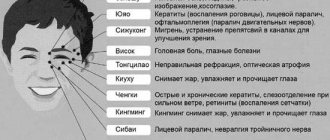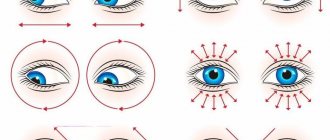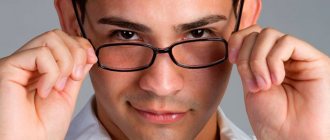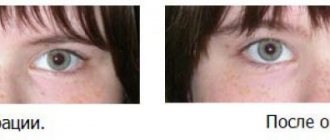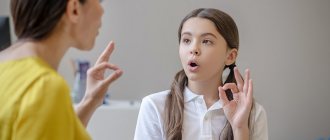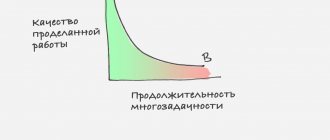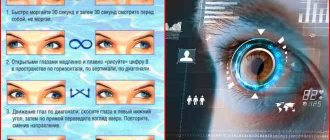Neuropsychological exercises for children Memo for teachers
THE NEUROPSYCHOLOGICAL COMPLEX OF EXERCISES IS AIMED AT CORRECTING DISORDERS IN THE MIND OF CHILDREN FROM 3 TO 12 YEARS OLD.
In childhood, two correction methods are used: motor and cognitive.
The first method promotes stimulation of individual zones of the cerebral cortex, which are responsible for the regulation of movements, improvement of interhemispheric interaction, and development of associative connections. Cognitive correction is aimed at developing cognitive skills and overcoming learning difficulties.
All neuropsychological exercises for children are carried out in strict sequence and under the supervision of an adult. Then they contribute to the activation of higher psychological functions: emotions, perception, attention, memory, thinking. In this way, the baby learns to overcome the maladaptive features of his development, his childhood behavioral problems and difficulties in school learning and self-regulation disappear.
Kindergarten No. 24
Psychological and pedagogical service
Neuropsychological exercises for children
Memo for
teachers
Vladikavkaz
"River-bank"
You will need a rope, it needs to be placed on the floor so that it marks the coastline.
The participant stands on one side of the rope, on the other the river flows. The psychologist invites the child to follow his commands “river”, “bank”. The child must jump accordingly.
In the first part of the game, the psychologist randomly gives commands and sees if the child can carry them out correctly. Then he begins to give them in the correct order until the baby gets used to it.
Suddenly the order changes, the child’s task is to switch. If he regularly makes mistakes, he should be asked to take his time. This is good for dealing with impulsiveness.
"Robot Mom"
This exercise is aimed at getting the child to tell the other person what to do. Moreover, he should mainly speak, and not show.
You should imagine that mom has forgotten how to do the most ordinary things and she needs a guide to help with this.
You should do what the child says literally, without adding anything of your own. If you don’t need to cut the bread to create a sandwich, then this is exactly what you should repeat. It is important that the child sees that the result of his planning is not exactly what it should be, and that he adjusts his actions.
Another option is to blindfold the mother and let the child explain how to get to a certain place or object. This must be done by indicating the number of steps.
"Fly"
You need to take a piece of paper and draw it into 16 cells (4 by 4). Separately, draw a fly and cut it out (you can use an object that will symbolize it, for example, a button). Place the fly on an arbitrary cell and order it to move in a certain direction.
After several such orders (a cell up, two cells down, etc.), ask the child where the fly is now. If the correct answer is given, move it to the appropriate square; if not, repeat and demonstrate its movement.
“I’m silent - I whisper - I scream”
You should come up with signs that indicate what exactly needs to be done: be silent, whisper or shout and show them to the child. He must react accordingly.
Such neuropsychological games and exercises develop control skills in hyperactive children. They help them regulate the volume of their statements and remain silent when necessary.
"Touch"
To play, you will need objects made from various materials: glass, wood, fur, etc. They should be placed on the table near the child, and he should be blindfolded. Offer to determine what exactly the object is in his hands.
Game for developing attention “Corrector”
First of all, you should explain to your child what exactly a proofreader does. Next, take a large magazine or book and select the “wrong” letters in it, for example, Ж, И, Б. Moreover, this must be done within a certain time.
Exercise "Robot"
.
Many children enjoy playing this game. It’s like he becomes a robot himself and carries out the commands given to him. The specialist gives the command “left hand up, right hand forward, two steps forward, one step to the right, and so on.” All commands should be given gradually so that the child does not get confused or become nervous; it is very important that the child learns the success of following commands. It is better to perform such exercises in front of a mirror so that the child can observe how he performs the exercises and moves like a robot. After 2-3 lessons, the child will learn where left and right are and will follow all commands clearly. You need to do the exercises for no more than half an hour so that the child does not get tired and lose interest. After 3-4 sessions, you can add movements: perform them above your head, under your nose, behind your ear, in front of your eyes. Then add elements above and below. The movements can already be performed without a mirror, closing your eyes. When the robot has clearly completed the exercises, you can add another game.
"Confusion"
.
You need to give commands, but do everything incorrectly, so that the child corrects the mistake himself and does everything as asked. Thus, it is good to concentrate the child's attention.
"Photographer".
An adult turns into a capricious photographer who can’t arrange his toys to take a photo. In this case, the child is involved in the game and asked to place the toys correctly: a bun to the right of the bear, an elephant to the left of the doll, and to build a pyramid of cubes behind the toys. Place a puzzle mat in front of the toys. After taking a photo, you can change the position of the toys. After looking at the photo on the computer, you can ask the child where which toy is located.
“What first, what then?”
.
Children are asked questions: What season is over? What time is it now? What will happen next? What time of year does the year begin? After what season does spring come? You can lay out pictures in front of your child and invite him to put them in order - according to the seasons.
“Find the same number”
.
Numbers cut out of different materials are laid out in front of the child: wood, fabric and others. He needs to find the same numbers, for example, all 3.
“Find out the number by touch”
.
The cut out numbers are placed in a bag, the child puts his hand into it and looks for the suggested number, for example 1.
"Make a figure"
.
The child is asked to put together a geometric figure from several parts: a square, a circle, a rectangle.
"Big, small, medium"
.
Objects of different sizes are laid out in front of the child, and he is asked to arrange them into three piles according to size.
“Collect a picture.”
Any picture from a book or postcard is cut into 6-8 parts and the child is asked to assemble the picture.
"Language for Sound"
- inclusion of auditory attention.
I.P. lying on your back.
Instructions: “You close your eyes and hear this sound... When you hear it, you will need to point in this direction with the tip of your tongue (finger, hand, explain where the sound is coming from)”
A more complex version using two noise sounds.
After the task, the child should receive feedback - an assessment of his actions.
Running time is approximately 1 minute.
Raising arms and legs for a count
I.P. lying on your back. At the same time, the arm and leg (of the same and/or opposite names) are raised to count.
Instructions: “I will count to 5, and you slowly and smoothly raise your arm and leg. On the count of "5"
the arm and leg should
“look”
at the ceiling.”
It is important that the movements are synchronous, uniform, movements must be performed without swaying, smoothly, without fixing points.
Any score within 10.
"Rock on your back"
I.P. sitting in a group, chin lowered to the chest, legs pressed to the stomach, rolls on the “round”
back. When performing the exercise, the head should not touch the floor (first, an adult’s hand is placed under the head), the chin should be pressed to the chest (during training, you can hold a toy with it).
The exercise is performed 5 – 10 times.
"Belly Rocker"
– vertical alignment
I.P. lying on your stomach. Hands grab the ankle.
The main task is to maintain balance when swinging back and forth.
The exercise is performed 5 – 10 times.
"Log"
- building a horizontal line
I.P. lying on your back.
The child’s task is to roll from one toy to another, placed in a straight line, holding the line. At first this line may be a ribbon.
The arms can be extended upward or pressed towards the body. During the exercise, it is necessary to achieve smooth movements.
"Stomach Crawl"
I.P. – lying on your stomach, bent arms and legs pressed to the floor.
It is important to achieve coordinated work of arms and legs.
"Crawling on your back"
I.P. lying on your back, arms bent at the elbows, holding the shoulders, legs bent at the knees.
Without touching your head to the floor and making circular movements with your arms, “swim on your back”
.
The exercise is energy-filling.
The work of the shoulder girdle and hand-foot coordination are important.
"Big Caterpillar"
- sitting stage.
I.P. Sitting, hands rest on the floor behind the body.
Folding your knees, move forward (backward) with maximum amplitude and coordinated work of your arms and legs.
"Little Caterpillar"
.
I.P. Sitting on the floor, legs together, straight, hands on your knees.
Knees do not bend, “crawling on buttocks”
.
"Spider"
I.P. stand on bent arms and legs with your stomach up.
First, training is carried out to move forward - backward, then move one-sided - ambidextrous arm - leg (each method of movement is practiced separately).
"Crab"
I.P. as in the previous exercise, but the movement is performed sideways. Steps are practiced with the same and opposite limbs.
It is necessary to ensure that the arms and legs do not overtake each other.
"Cat"
,
“cat on the elbows”
(basic) – coordination of 4 points.
I.P. When kneeling and on your forearms or elbows, your gaze is directed forward. First, movement while maintaining balance is practiced, then unilateral, versatile. Make sure that your palms and toes are on the floor.
"Bridge"
— the vector changes to lateral.
I.P. rest on your palms and knees with your stomach down, move sideways with an extended step, along a given trajectory.
"Socks - palms"
- breeding synkenesis.
I.P. sitting on the floor, legs straight, back resting on the wall, arms bent at the elbows, palms open at shoulder level perpendicular to the floor.
The movements of the hand and toe are the same and opposite.
"Climber"
Standing on his feet, the child must walk along the wall as if it were a rock. Palms are pressed against the wall, you can “tear them off”
only one limb.
"March"
Steps of the same and different names. For each step, the hand touches the opposite shoulder.
These exercises are the main (basic) ones in the motor program.
“Neuropsychological exercises or exciting gymnastics for the brain”
“Neuropsychological exercises or exciting gymnastics for the brain”
Modern teachers understand that pedagogical methods alone cannot solve all of a child’s learning problems. Of course, psychological characteristics and social environment always have their influence. But beyond this, there are processes that are more deeply related to the development of the brain in the first years of life. Adherents of neuropsychology argue: a child may not feel spelling, for example, due to the fact that he missed the crawling stage in infancy.
Child neuropsychology is a very young but rapidly developing science that provides answers to many questions surrounding child behavior and perception.
Neuropsychology is an interdisciplinary branch of science that was formed at the intersection of psychology and physiology. Neuropsychology studies the connection between processes occurring in the brain and mental processes and behavior.
There is no one structure in the brain that is responsible for memory, speech, attention, and so on. For any HMF, because it is so complex, there is a whole orchestra of structures that are interconnected.
One of the founders of neuropsychology was the Soviet psychologist and neuropathologist Alexander Luria. He developed a theory about three functional blocks of the brain. He divided brain structures and sets of these structures into key blocks. (That is, what our brain does to ensure HMF). VPF is a functional system that consists of several links. Each HMF depends on the work of 3 functional blocks of the brain.
These processes are the main ones that determine the success of a child’s development and learning ability. If they are not formed, then learning is difficult, a dislike for learning appears, and psychosomatic diseases may develop.
The peculiarity of children's neuropsychology is that the brain is very plastic until the age of 11. At an early stage it is easier to solve problems, but if they are left “as is”, they will only take root and build on one another.
How to understand that a child needs help from a neuropsychologist?
The brain is an instrument whose quality determines a person’s entire life. If a child cannot maintain rules of behavior and apply spelling rules, this primarily signals a lack of willpower and self-control, for which certain areas of the brain are responsible. There are children who show talent in mathematics, do interesting creative projects, but often make “stupid” mistakes in Russian language lessons. Obviously, this is not a matter of undeveloped intellect.
Signs of neuropsychological problems
- does not remember information well
- can't concentrate
- has poor self-control
- reads slowly
- awkward in movements,
- exhausted (no energy)
- doesn't sleep well
- writes letters in reverse
- has obsessive movements
- has macro- or micro-handwriting,
- has unformed interhemispheric interaction.
There are no children who would like to study poorly. But there are children who cannot study well. In elementary school, simple exercises in class or in additional classes in the form of exercises or game assignments help to cope with some problems. The main thing is to understand that everything in the human body is interconnected and the success of a child depends on how well he knows how to manage himself.
Why are neuropsychological exercises needed?
Neuropsychological exercises are the most effective technique that allows, without the use of medications, to help children with various types of disorders. These include: hyperactivity, attention deficit disorder, developmental delay and others.
For children, this technique is completely safe and does not cause any unwanted effects. With the right and qualified approach, high results can be achieved.
In these exercises, the main element is sensorimotor (motor) plus breathing exercises - this is what modern children currently lack. Breathing is the simplest, most familiar process that is easy to manage. There are many breathing exercises through which children learn to concentrate and control their organs.
Examples of simple exercises for brain development.
- You need to take a notebook sheet and tear it in half. The child takes one half in each hand (it is important that the elbows do not touch anything) and at the same time crushes them so that the entire piece of paper is hidden in the fist. Then he needs to calmly, slowly and simultaneously straighten these leaves. Each hand should work independently and without helping one another.
(why it’s useful: when the fingers of both hands work, different parts of the brain are activated. The sheet crumples differently each time, so the fingers need to work differently each time.)
It has been proven that there is a relationship between the coordination of human movements and the functioning of the brain! Since the brain, through nerve impulses, controls the functioning of all human organs and limbs. Moreover, the brain carries out fine coordination of human activities associated with balance. Experts also noticed that when a person, after regular training, masters dancing, tightrope walking, and standing on one leg for a long time, his brain function miraculously improves.
- Four simple exercises with a ball that will not only appeal to children of all ages, but will also train coordination and develop the brain accordingly.
You will need a ball or any round object. You can even use paper crumpled into a ball, it doesn’t matter.
1) Imitation of the actions of a juggler - toss a ball with one hand and catch it with the other. After a series of trainings, you can complicate the exercise and catch the ball with your eyes closed.
2) You need to throw the ball from below with one hand, and grab it from above with the other. Alternate hands with each other.
3) Throw the ball from one hand to the other in front of you and behind your back.
4) Pass the ball behind the shoulder blades from different sides. Gradually increase the pace of movements.
3. Fine motor skills are the ability to reproduce precise movements with the hand and fingers. This is important not only for developing beautiful handwriting, we must also remember that the phalanges of the fingers are the main tools in the work of representatives of many professions. The development of fine motor skills in children aged 6-7 years is facilitated by drawing, playing musical instruments, working with plasticine and small construction sets. But the greatest effect is obtained as a result of special classes.
The exercises offered to children help develop accuracy and speed of movement. As a result of their implementation, the hands and fingers will become stronger, flexible and mobile. There are three types of such tasks:
- exercises with small objects;
- graphic tasks;
- finger games.
Here is a simple exercise that requires minimal preparation, but is also very useful for the development of fine motor skills, and therefore the brain.
You need to take A4 sheet, plain rice and toothpicks. On a sheet of paper you need to draw small lines (2-3cm) and dots in a chaotic order. Then you need to place toothpicks on these lines, and on the points in Fig. You need to take them in turn, first with the thumb and index finger, then the thumb and middle finger, then the thumb and ring finger, and the thumb and little finger of the right hand. Then repeat the exercise with your left hand and then with both hands at the same time.
Today, the benefits of neuropsychological exercises for children of different ages have been proven. They promote activation of the brain, namely higher mental functions: perception, attention, memory, thinking. Thus, the child learns to overcome the maladaptive features of his development, his childhood behavioral problems and difficulties in self-regulation and, accordingly, in school learning disappear.
Neuropsychological exercises psychology article on the topic
NEUROPSYCHOLOGICAL EXERCISES
Oculomotor repertoire.
1.Working on eye movements on 4 sides (top, bottom, right, left); towards yourself (bringing the eyes to the bridge of the nose) and away from yourself. First, the child follows the toy in the adult’s hand, then the toy in the child’s hands at arm’s length (the adult moves the child’s hand), then the child independently moves the hand with the toy at arm’s length, then the toy in the child’s hands at elbow distance. The exercise is practiced lying down at a slow pace with fixation in extreme positions for up to 3 seconds.
First with the right hand, then with the left and then with both hands together.
Try to keep the eye movement smooth and holding the object with the eyes in extreme positions stable.
In the future, this exercise can be practiced while sitting or standing.
2.Tracking an object moving along an imaginary contour of a circle, oval, triangle, square, inverted figure eight. The child moves the object.
3. The adult draws in the air in front of the child various vertical, horizontal, curved lines, various figures, letters, numbers,
which the child must identify, draw in the air, then on paper.
4. Combine the eye movements described in the 1st exercise with the movement of the tongue in the same direction as the eyes and in the opposite direction (start practicing opposite movements when the eyes are already moving well, there will be good retention in extreme positions for up to 5 seconds). When practicing this exercise, pay attention to the fact that the movements of the eyes and tongue are simultaneous.
GENERAL MOTOR REPERTOIRE.
Lying on your back
1.Stretches - arms up, legs down. Then right hand, right foot; left hand, left leg. Then different arms and legs.
“Rocking chair”: clasp your knees with your hands, swing on your back, then roll on either the right or left side, and at the command of an adult, freeze on one side.
2. A modified version of the “bicycle”: imitation of riding a bicycle with his feet, with the child touching the opposite knee with his elbow (palm), then the knee of the same name, then again the opposite one.
3. Simultaneous movements of the eyes, tongue, arms, legs up, down, right, left, then multidirectional movements. Do these exercises when the oculomotor exercises from the previous section are well mastered.
4.Crawling on your back without using your hands (“Worm on your back”). You can help with your feet if it’s difficult.
Lying on your stomach.
1.Crawl forward, backward (using only arms, only legs), like a snake, like a spy, like a partisan, etc. d., roll left and right.
2. With the body in a fixed position, swing your shins left and right, then combine this with turning your head, first in the same direction as your shins, then in the opposite direction.
Sitting
- The tongue is fixed in one position - either hidden with the mouth open (the tip of the tongue is lowered behind the lower teeth), or extended forward as much as possible, or the jaws are tightly clenched. Combined hand and eye movements are performed:
- hands lie on the knees, alternately the right hand hits the right knee, then the left hand hits the left, simultaneously with the blow, eye movements are performed in the same direction, then in the opposite direction;
- Crossed hands lie on the knees, alternately the right and left hand strike opposite knees, simultaneously with the strike, the eyes move in the same direction and then in the opposite direction from the hand.
Similarly, combined movements of the tongue and hands are performed with a directly fixed gaze.
- Hands lie on your knees (stretched forward; to the sides), thumbs up. Unidirectional and multidirectional movements of the hands with the eyes and tongue are performed. Can also be performed standing.
On knees.
It is advisable to mark the child’s left hand with a cloth, bracelet or rubber band (put it on the hand).
A tape is laid out on the floor. The child moves along the tape back and forth while simultaneously moving the arms and legs of the same name, then the opposite ones.
Then the hands are placed on the tape one after another, the right hand goes to the left side, and the left to the right (“BEAR BEAR”) Each run is performed 3-4 times. In the future, you can crawl on all fours sideways to the right and left. Movements of the eyes, tongue, arms, legs are also added.
